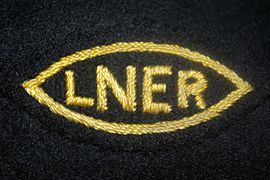London and North Eastern Railway facts for kids
 |
|
| Overview | |
|---|---|
| Dates of operation | 1923–1948 |
| Predecessor | Great Eastern Railway Great Central Railway Great Northern Railway Great North of Scotland Railway Hull and Barnsley Railway North British Railway North Eastern Railway and others |
| Successor | Eastern Region North Eastern Region Scottish Region |
| Technical | |
| Track gauge | 4 ft 8 1⁄2 in (1,435 mm) |
| Length | 6,590 miles (10,610 km) |
The London and North Eastern Railway (LNER) was a very important railway company in Britain. It was the second largest of the "Big Four" railway companies. These big companies were created by a law called the Railways Act 1921.
The LNER started on January 1, 1923. It ran trains for 25 years. On January 1, 1948, the government took over all the railways. This is called nationalisation. The LNER was then split into parts of the new British Railways. These parts included the Eastern Region, North Eastern Region, and some of the Scottish Region.
What Was the LNER?
The London and North Eastern Railway, or LNER, was one of the biggest railway companies in Britain. It was formed from many smaller railway companies. These included the Great Eastern Railway and the Great Northern Railway. The LNER covered a huge area. It stretched from London all the way up to Scotland.
The LNER was known for its fast and stylish trains. It also had excellent service. People used LNER trains for both travel and moving goods. It helped connect many towns and cities across the eastern side of Britain.
How the LNER Started
Before 1923, there were over 100 different railway companies in Britain. The government decided to combine them into just four large companies. This was done to make the railways more efficient. The LNER was one of these four new "Big Four" companies.
The Railways Act 1921 was the law that made this happen. It brought together many smaller lines. This included lines from the east of England and Scotland. The LNER inherited a vast network of tracks. It also got many different types of locomotives and carriages.
Famous LNER Trains
The LNER was famous for some of the most iconic trains in history. These trains were known for their speed and design. They captured the imagination of many people.
- The Flying Scotsman: This was one of the most famous trains in the world. It was an A3 Class locomotive. The Flying Scotsman ran between London and Edinburgh. It was known for its speed and luxury.
- Mallard: This A4 Pacific locomotive set a world speed record. On July 3, 1938, Mallard reached 126 miles per hour. This was the fastest speed ever recorded for a steam train. It still holds that record today.
These trains showed how advanced LNER's engineering was. They were a symbol of British railway power.
End of the LNER
The LNER existed for 25 years. After World War II, the British government decided to take control of all major industries. This included the railways. On January 1, 1948, the LNER stopped being a private company. It became part of the new state-owned British Railways.
The LNER's lines and trains were then divided. They became part of different regions of British Railways. These included the Eastern, North Eastern, and Scottish Regions. Even though the LNER no longer existed, its legacy lived on. Many of its famous locomotives continued to run for years.
Images for kids
-
Timetable for Autumn 1926 detailing the resumption of services after the General Strike
-
Detail of LNER teak panelled coaches, preserved on the Severn Valley Railway





